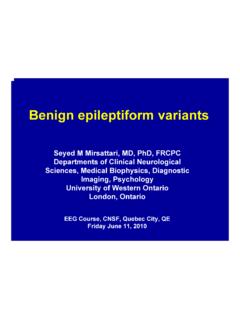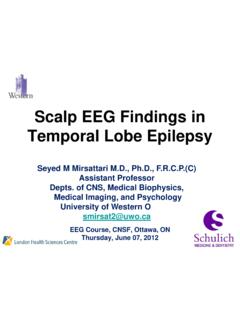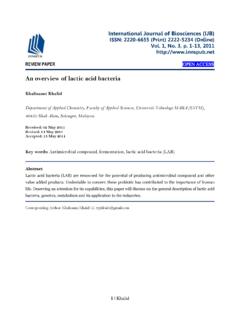Transcription of Periodic Lateralized Epileptiform Discharges
1 Periodic Lateralized Epileptiform DischargesPaolo Federico MD, PhD, FRCPCD epartments of Clinical Neurosciences and Diagnostic ImagingUniversity of Calgary11 June 2010 Learning Objectives Understand the principal EEG features of PLEDs Describe the different types of PLEDs Understand the evolution of PLEDs List the main etiologies of PLEDs Know the clinical associations of PLEDs2/28 Disclosure Statement;I have nothing to disclosePLEDsPLEDs = Periodic Lateralized Epileptiform Discharges First described by Echlin (1952) First defined by Chatrian(1964) Uncommon ( of all EEG recordings)4/285/28 From Fitzpatrick & Lowry, CJNS 34:443-450,2007. PLEDs -Features Lateralized or focal Period (or near Periodic ) Usually electronegative bi-, tri-and polyphasicspikes and sharp waves Amplitude 50-300 V, duration 20-1000 msec(mean 200 msec) Present for most of recording Usually maximal on the side of a structural lesion Ipsilateral background slowing on side of PLEDs Ipsilateral reduction of background reactivity6/28 PLEDs plus First reported by Reiher(1991) PLEDs with admixed rhythmic high frequency, low voltage polyspikes7/288/28 From Fitzpatrick & Lowry, CJNS 34:443-450,2007.
2 BIPLEDs Complexes are present over both hemispheres, but are asynchronous Discharges usually differ in morphology, amplitude, rate of repetition, and site of maximal involvement between hemispheres First recognized by Chartain(1964) Formally characterized by de la Paz & Brenner (1981)9/2810/28 From Fitzpatrick & Lowry, CJNS 34:443-450,2007. Multifocal PLEDs First reported by Reeves & Thompson (1993) PLEDs occurring independently in 3 cerebral regions11/2812/28 From Lawn et al. ClinNeurophysiol111:2125-2129, 2000. Chronic PLEDs First described by Westmoreland et al. (1986) Very rare PLEDs lasting at least 3 months (up to 20 years) Seen in patients with chronic brain lesions and focal seizures13/2814/28 From Fitzpatrick & Lowry, CJNS 34:443-450,2007.
3 PLEDs Etiology62 year old female with HSV encephalitis Ischemic stroke (34%) Infection (16%) Tumor (13%) Hemorrhage* (9%) Metabolic (6%) Anoxia (5%) CJD (1%) Unknown (3%) Other (13%)* Includes all intracranial hemorrhages: intracerebral, subdural, and epidural hematoms15/28 From Fitzpatrick & Lowry, CJNS 34:443-450,2007. BIPLEDs Etiology Infection (28%) Anoxia (28%) Chronic seizure disorder (22%) Other (22%)* Includes all intracranial hemorrhages: intracerebral, subdural, and epidural hematomas16/28 From de la Paz & Brenner, Arch Neurol38:713-715, evolution Typically a transient phenomenon Usually seen in the acute state (usually < 24 hrs after onset ofillness) 50% of PLEDs disappear after several days 90% of PLEDs disappear within 4 weeks Exception.
4 Chronic PLEDs Morphological changes Interval between Discharges increase Change into either monomorphic, high-voltage slow waves or sporadic spikes and sharp waves Then evolves into focal, paroxysmal theta and delta waves (in the region of the PLEDs) and then totally disappearing 17/28 PLEDs Clinical Correlates Focal seizures Approximately 75% of patients have clinical seizures Focal motor most common Tend to arise from the site of maximal involvement Generalized seizures without focal clinical signs or EEG onset more likely in BIPLEDs Focal neurologic signs Obtundation More likely in patients with BIPLEDs18/28 PLEDs: Interictal or Ictal Phenomenon? Generally considered an interictal phenomenon EEG features do not meet strict criteria of an ictal rhythm Can be ictal in some cases Epilepsia partialis continua Case reports of recurrent, prolonged episodes of confusional states associated with PLEDs (Terazano 1986) PLEDs can be viewed as an EEG signature of a dynamic pathophysiological state with underlying neuronal injury that is influenced a variety of factors ( , toxic, metabolic, infectious, pre-existing illness).
5 19/2820/28 From Brenner & Schaul, J ClinNeurophysiol7:249-267, 1990. PLEDs Imaging Correlates No unique anatomical site or distribution of sites associated with PLEDs No association of cortical vs subcortical vs combined cortical/subcortical involvement, although purely subcortical lesions less likely to be associated with PLEDs PET/SPECT may show increased activity in region where PLEDs are seen21/28 PLEDs Treatment Adequate data not available Seizures should be managed no differently than if PLEDs were absent Some authors recommend aggressive AED treatment whether or not seizures occur ( Handforthet al. 1994) Consider continuous EEG monitoring in obtunded or comatose patients, to detect nonconvulsiveseizures (seen in > 50% of pediatric patients)22/28 PLEDs Prognosis Largely determined by underlying process Acute stroke has worst prognosis ( ) However, influence of PLEDs on prognosis unclear Potentially reversible conditions have ( , metabolic encephalopathies, EtOH withdrawal) have a better prognosis23/28 From de la Paz & Brenner, Arch Neurol38.
6 713-715, Mechanisms Wide EEG distribution, suggests a large generator Cobb and Hill (1950) cortical isolation hypothesis Periodicity occurs when the cortex is disconnected Gloor (1968) refined explanation Brain is in a functional state that permitted rapid synchronization/generalization of neuronal Discharges , ephatic interactions, virus-induced fusion of neuronal processes, intrinsic Ca+ and K+ conductances Periodicity is a result of the refractory state and recovery cycle of both cortical and subcortical neurons Glutamate-mediated excitotoxicity likely important24/28 Future Directions What is true incidence of PLEDs? When do PLEDs occur and how do they evolve? What is relationship of PLEDs to seizures?
7 Should PLEDs be treated prophylactically?25/28 Thank you











